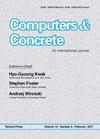采用混凝土试件对隧道支护中混凝土节点性能进行了试验与数值模拟
IF 3.3
4区 工程技术
Q2 COMPUTER SCIENCE, INTERDISCIPLINARY APPLICATIONS
引用次数: 3
摘要
利用二维颗粒流程序模拟了隧道周围岩体与附近岩体节理或结构面相互作用的特性。专门制备的试样在实验室进行了测试,并提供了测量结果。然后利用标定后的二维颗粒流程序对这些试验进行数值模拟,研究岩石隧道在与邻近节理相互作用时的行为。二维离散单元代码采用巴西拉伸试验标定。在此基础上,提供了模拟试样,对单轴压缩条件下隧道断面及相邻节理的各种形态进行了试验。研究表明,拉伸裂纹是这些模型试样中最主要的开裂形式。机翼裂纹是在节理相互作用小于隧道高度时从节理尖端开始的。这些裂缝随后扩展并与隧道顶板相互作用。当节理与隧道头相互作用且相互作用角度为负时,考虑到节理对隧道失稳的影响,隧道处于稳定位置。但对于正相互作用角和节理存在于隧洞顶部附近的情况,翼面裂纹可能产生并向隧洞顶部扩展。随着节理距顶板距离的增大,其破坏应力增大,对隧道失稳的影响减小。节理的数量及其与隧道边界(顶板)的距离对隧道的稳定状况也有深远的影响。从-30°增加到-60°或从30°增加到60°时,破坏应力达到最大值。破坏应力随缺口数量和长度的增加而减小。在所有的相互作用情景下,对相应的数值和实验值进行了比较,得出了破坏应力非常接近的结论,验证了所提出的建模技术的准确性和适用性。本文章由计算机程序翻译,如有差异,请以英文原文为准。
A coupled experimental and numerical simulation of concretejoints' behaviors in tunnel support using concrete specimens
The experimentally tested modelled specimens were simulated by a two-dimensional particle flow code to study the behavior of rock mass surrounding a tunnel interacted with a nearby rock joint or discontinuity. The specially prepared specimens are tested in the laboratory and the measured results are provided. Then a numerical modelling of these tests is accomplished by a calibrated two-dimensional particle flow code to study the rock tunnel behavior while interacting with a neighboring joint. The two-dimensional discrete element code was calibrated using Brazilian tensile test. Then the modelled specimens are provided so that various configurations of tunnel cross sections and the neighboring joints were tested under uniaxial compression condition. This study showed that the tensile cracks are the most dominant mode occurred in these modelled samples. The wing cracks initiated from the joint tips when the joints interacted in a position less than that of the tunnel height. These cracks are then propagated and interacted with the tunnel ceiling. When the joint interacting the tunnel head and the interaction angle is negative the tunnel can be in a stable position considering the joints effect on its instability situation. But for positive interaction angles and the case of joint existing near the tunnel head, the wing cracks may initiate and propagate towards the tunnel ceiling. As the distance of joint from the tunnel ceiling is increased its effect on the tunnel instability is decreased because the failure stress is increased. The number of joints and their distance with the tunnel boundary (ceiling) have also a profound effect on the stability condition of the tunnel. The failure stress reached its maximum value for the increase from -30 to -60 degrees or increase from 30 to 60 degrees. The failure stress also decreased as the number of notches and their lengths increased. In all these interaction scenarios, the corresponding numerical and experimental values compared and it is concluded that the failure stresses are very close to each other which verified the accuracy and applicability of the proposed modeling technic.
求助全文
通过发布文献求助,成功后即可免费获取论文全文。
去求助
来源期刊

Computers and Concrete
工程技术-材料科学:表征与测试
CiteScore
8.60
自引率
7.30%
发文量
0
审稿时长
13.5 months
期刊介绍:
Computers and Concrete is An International Journal that focuses on the computer applications in be considered suitable for publication in the journal.
The journal covers the topics related to computational mechanics of concrete and modeling of concrete structures including
plasticity
fracture mechanics
creep
thermo-mechanics
dynamic effects
reliability and safety concepts
automated design procedures
stochastic mechanics
performance under extreme conditions.
 求助内容:
求助内容: 应助结果提醒方式:
应助结果提醒方式:


